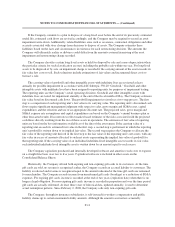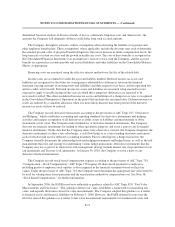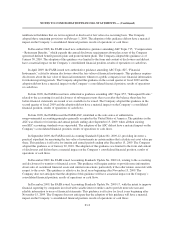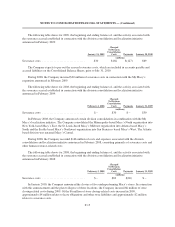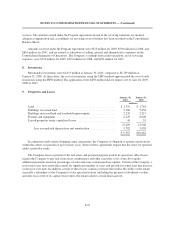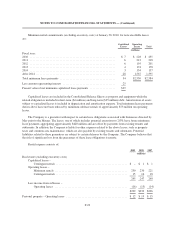Macy's 2009 Annual Report Download - page 65
Download and view the complete annual report
Please find page 65 of the 2009 Macy's annual report below. You can navigate through the pages in the report by either clicking on the pages listed below, or by using the keyword search tool below to find specific information within the annual report.
NOTES TO CONSOLIDATED FINANCIAL STATEMENTS — (Continued)
to certain store locations being less than the carrying value of those assets, the Company recorded impairment
charges of $115 million and $136 million in 2009 and 2008, respectively. The fair values of these locations were
calculated based on the projected cash flows and an estimated risk-adjusted rate of return that would be used by
market participants in valuing these assets or based on prices of similar assets.
The Company performed both an annual and an interim impairment test of goodwill and indefinite-lived
intangible assets during 2008 (see Note 4, “Goodwill Impairment Charges”). During 2008, management
concluded that $63 million of asset impairment charges were required in relation to indefinite-lived acquired
tradenames. As a result of the then-current economic environment and expectations regarding future operating
performance of the Karen Scott, John Ashford and Frango private brand tradenames, it was determined that the
carrying values exceeded the estimated fair values, which were based on discounted cash flows, by
approximately $63 million.
The Company accounts for its investment in available-for-sale marketable securities with unrealized gains
and losses being included as a separate component of accumulated other comprehensive income. During 2008,
based on the then-current economic environment, it was determined that the carrying value of certain marketable
securities exceeded the current fair value on an “other-than-temporary” basis, by approximately $12 million, and
the previously unrecognized losses in accumulated other comprehensive income were reclassified into the
Consolidated Statements of Operations.
4. Goodwill Impairment Charges
The Company reviews the carrying value of its goodwill and other intangible assets with indefinite lives at
least annually for possible impairment in accordance with ASC Topic 350, “Intangibles – Goodwill and Other.”
Goodwill and other intangible assets with indefinite lives have been assigned to reporting units for purposes of
impairment testing. The reporting units are the Company’s retail operating divisions. Goodwill and other
intangible assets with indefinite lives are tested for impairment annually at the end of the fiscal month of May.
The goodwill impairment test involves a two-step process. The first step involves estimating the fair value of
each reporting unit based on its estimated discounted cash flows and comparing the estimated fair value of each
reporting unit to its carrying value. If this comparison indicates that a reporting unit’s estimated fair value is less
than its carrying value, a second step is required. If applicable, the second step requires the Company to allocate
the fair value of the reporting unit to the estimated fair value of the reporting unit’s net assets, with any fair value
in excess of amounts allocated to such net assets representing the implied fair value of goodwill for that reporting
unit. If the carrying value of an individual indefinite-lived intangible asset exceeds its fair value, such individual
indefinite-lived intangible asset is written down by an amount equal to such excess.
The Company uses judgment in assessing whether assets may have become impaired between annual
impairment tests. The occurrence of a change in circumstances, such as continued adverse business conditions or
other economic factors, would determine the need for impairment testing between annual impairment tests. Due
to deterioration in the general economic environment in recent periods (and the impact thereof on the Company’s
then-most recently completed annual business plan) and the resultant decline in the Company’s market
capitalization, the Company believed that an additional goodwill impairment test was required as of January 31,
2009. In performing the first step of this impairment test, the Company estimated the fair value of its reporting
units by discounting their projected future cash flows to present value, and reconciling the aggregate estimated
fair value of the Company’s reporting units to the trading value of the Company’s common stock (together with
an implied control premium). The Company believes that this reconciliation process represents a market
participant approach to valuation. Based on this analysis, the Company determined that the carrying value of
each of the Company’s reporting units that exceeded its fair value at January 31, 2009, which resulted in all of
F-17






